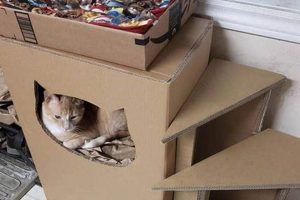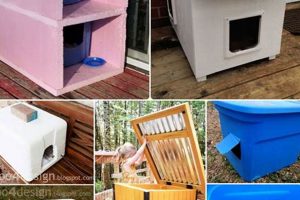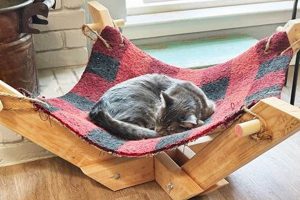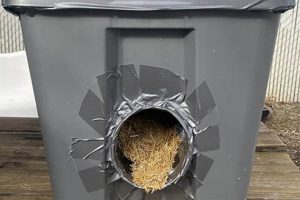A do-it-yourself approach to creating a protective device for felines after surgery or injury involves constructing a collar designed to prevent the animal from licking or scratching affected areas. These homemade solutions offer an alternative to commercially available veterinary cones, utilizing readily available materials. For instance, individuals might fashion a collar from fabric, foam, or even repurposed household items to achieve the necessary protective barrier.
This practice provides several advantages. It can be a more cost-effective option compared to purchasing a cone from a veterinarian or pet store, particularly beneficial for pet owners on a budget. Furthermore, crafting a custom collar allows for a more personalized fit, potentially enhancing the animal’s comfort and reducing stress associated with wearing a restrictive device. Historically, variations of protective collars have been used in animal care to aid in healing and prevent self-inflicted harm, predating modern veterinary medicine.
The subsequent sections will detail different methods for constructing such collars, exploring material choices, design considerations to ensure safety and effectiveness, and essential fitting guidelines to maximize comfort and compliance for the feline patient.
Essential Construction and Application Guidelines
The following guidelines provide crucial information for successfully creating and implementing a protective collar alternative. Adherence to these points will contribute to the safety and efficacy of the device.
Tip 1: Material Selection: Prioritize soft, non-toxic materials to minimize irritation and prevent accidental ingestion. Avoid sharp edges or components that could pose a choking hazard.
Tip 2: Accurate Measurement: Obtain precise neck and head circumference measurements to ensure a secure yet comfortable fit. An improperly sized collar can be ineffective or cause undue stress.
Tip 3: Secure Fastening: Implement a reliable closure mechanism, such as adjustable straps or Velcro, to prevent the cat from easily removing the collar. Regularly inspect the fastening for signs of wear or weakness.
Tip 4: Limited Peripheral Vision: Design the collar to minimize obstruction of the cat’s peripheral vision, which can induce anxiety and disorientation. A wider field of view contributes to improved mobility and reduced stress.
Tip 5: Gradual Introduction: Introduce the collar to the cat slowly, allowing for acclimatization. Positive reinforcement, such as treats or praise, can encourage acceptance.
Tip 6: Supervised Usage: Initially, supervise the cat while it is wearing the collar to monitor for any signs of distress or difficulty navigating its environment. Adjustments may be necessary to optimize comfort and safety.
Tip 7: Regular Cleaning: Maintain hygiene by regularly cleaning the collar to prevent the accumulation of bacteria and odors. Use a mild, pet-safe cleaning solution and ensure the collar is completely dry before reapplication.
The success of this protective solution hinges on careful planning, precise execution, and diligent monitoring. By following these guidelines, a comfortable and effective recovery aid can be provided, protecting the animal from self-inflicted injury and promoting healing.
The subsequent sections will delve into the maintenance, monitoring and other essential details to ensure the safety and well-being of your cat while wearing it.
1. Material Safety
Material safety constitutes a paramount concern in the construction of a do-it-yourself feline protective collar. The inherent risk of ingestion, either through deliberate chewing or accidental detachment of components, necessitates the selection of non-toxic and biocompatible substances. The cause-and-effect relationship is direct: unsafe materials can lead to poisoning, gastrointestinal obstruction, or other adverse health events. For instance, using fabrics treated with chemical dyes or adhesives containing volatile organic compounds (VOCs) could result in chemical exposure and subsequent illness. Therefore, material safety is not merely a desirable attribute but a fundamental prerequisite for a responsibly designed protective collar.
The practical application of this principle requires careful consideration of material properties. Fabrics such as unbleached cotton or fleece, known for their softness and minimal chemical treatment, represent suitable choices. Fasteners, if used, must be securely attached to prevent detachment and subsequent ingestion. Hard plastics should be avoided due to the risk of splintering and causing internal injury. A real-life example underscores this importance: a cat ingesting a small plastic component from a poorly constructed collar could require emergency veterinary intervention to remove the obstruction. The potential for such scenarios highlights the critical need for diligent material assessment.
In summary, prioritizing material safety in the construction of a protective collar alternative directly safeguards the feline patient from potential harm. The absence of this consideration undermines the purpose of the device and transforms it into a potential health hazard. While cost-effectiveness and ease of construction are important factors, they must never supersede the imperative of selecting materials that are demonstrably safe for feline use. The challenge lies in balancing practicality with the highest standards of material safety, ensuring the collar serves its protective function without compromising the animal’s well-being.
2. Accurate Sizing
Accurate sizing is a fundamental element in the creation of a do-it-yourself feline protective collar. The efficacy and comfort of such a device are directly contingent upon precise measurements and proper fit. A poorly sized collar can negate its protective function or, conversely, cause undue distress and physical harm to the animal.
- Neck Circumference Measurement
The initial step involves obtaining a precise measurement of the cat’s neck circumference. This measurement dictates the inner diameter of the collar and ensures it is neither too constricting nor too loose. A collar that is too tight can impede breathing, restrict blood flow, and cause skin irritation. Conversely, a collar that is too loose will allow the cat to bypass the protective barrier and continue to access the injured area. An example of this is using a flexible measuring tape, ensuring a snug but not tight fit, and recording the measurement in centimeters or inches. Deviation from this accurate measurement renders the collar ineffective.
- Head Circumference Consideration
While neck circumference establishes the base diameter, head circumference is equally important to prevent the cat from slipping the collar off. The collar must be wide enough to prevent removal over the head, yet not so excessively large that it hinders movement or obstructs vision. A practical example involves measuring the distance from the back of the head to the chin to determine the minimum outer diameter of the collar. Failure to account for head size renders the collar functionally useless as the cat can easily remove it, defeating the purpose of protection.
- Collar Depth and Reach
The depth or reach of the collar its extension beyond the face is critical to prevent the cat from reaching the affected area. This dimension is influenced by the cat’s snout length and body flexibility. A shallow collar may not adequately prevent access to injuries on the legs or torso. Determining the appropriate depth often involves observing the cat’s reach with its head and forepaws. A collar too short will not prevent access to wounds; a collar too long can hinder movement and cause frustration. This dimension demands careful consideration of the cat’s individual anatomy.
- Adjustability Mechanisms
Incorporating adjustability mechanisms, such as straps, Velcro closures, or drawstrings, allows for fine-tuning the fit and accommodating minor fluctuations in size due to swelling or weight changes. These features enhance comfort and ensure a secure fit over time. An example includes adding Velcro straps that allow for incremental adjustments, providing a customized fit. The absence of adjustability limits the collar’s adaptability and can necessitate frequent replacements, negating the benefits of a do-it-yourself approach.
In conclusion, accurate sizing in the context of a do-it-yourself feline protective collar transcends mere measurement; it is a comprehensive assessment of anatomical dimensions and functional requirements. Each measurement contributes directly to the collar’s ability to protect the cat without causing unnecessary discomfort or restriction. Deviation from precise sizing compromises the device’s effectiveness and jeopardizes the animal’s well-being, highlighting the indispensable role of accurate measurements in the construction process.
3. Secure Fastening
The integrity of a do-it-yourself feline protective collar hinges significantly on the implementation of a secure fastening mechanism. The causal relationship is evident: an inadequate fastening system renders the entire device ineffective, regardless of material quality or accurate sizing. If the cat can easily remove the collar, its primary purpose of preventing access to wounds or surgical sites is nullified. The significance of secure fastening lies in its role as a critical control point within the overall protective strategy. An example would be a collar crafted from soft, comfortable material, perfectly sized to fit the cat, but secured only with a flimsy piece of string; this collar, though well-intentioned, offers little practical protection.
Practical application of secure fastening principles necessitates careful selection and implementation of closure methods. Options range from adjustable straps with buckles to hook-and-loop fasteners (Velcro) or strategically placed snaps. Regardless of the chosen method, the fastening must withstand the cat’s efforts to dislodge or remove the collar. This includes resistance to pulling, scratching, and chewing. A real-world example involves using a buckle that incorporates a locking mechanism, preventing accidental opening by the cat. Another example includes using high-strength Velcro that maintains its grip even when exposed to moisture or hair. The choice of fastening must consider not only its security but also its ease of use for the caregiver and its comfort for the animal.
In conclusion, secure fastening represents a crucial element in the design and construction of a protective collar alternative. It is not merely an accessory but an essential component that dictates the device’s overall efficacy. The challenges lie in balancing security with ease of use and feline comfort. A well-designed fastening system mitigates the risk of premature removal, thereby maximizing the protective benefits of the collar and contributing to the animal’s recovery. Failure to prioritize secure fastening undermines the entire endeavor, potentially delaying healing and increasing the risk of complications.
4. Vision Accessibility
Vision accessibility plays a crucial role in the design and acceptance of do-it-yourself feline protective collars. Impaired vision can lead to increased anxiety, disorientation, and decreased mobility, thereby negatively impacting the animal’s well-being and potentially hindering the healing process. An appropriately designed collar minimizes visual obstruction, allowing the cat to navigate its environment with confidence and reducing stress.
- Peripheral Vision Maintenance
The preservation of peripheral vision is paramount. Collars that significantly restrict the cat’s ability to see to the sides can induce fear and disorientation. A design that allows for a wide field of view is essential. An example would be opting for a clear, lightweight material for the collar’s extension, minimizing visual blockage while still providing the necessary protection. Neglecting peripheral vision can result in a cat bumping into objects, becoming hesitant to move, and experiencing increased stress levels, ultimately undermining the collar’s therapeutic purpose.
- Vertical Field of View
The vertical field of view, the cat’s ability to see above and below, must also be considered. An excessively long or poorly angled collar can obstruct the cat’s view of its immediate surroundings, including food and water bowls. This can lead to difficulties with eating and drinking, resulting in dehydration or malnutrition. A practical example involves ensuring that the collar’s edge is positioned above the cat’s nose when its head is in a neutral position, allowing it to see downward without obstruction. Failure to address the vertical field of view can create significant challenges for the cat in performing basic life functions.
- Material Transparency
The choice of material greatly impacts vision accessibility. Opaque materials inherently restrict vision more than transparent or translucent ones. Opting for materials that allow light to pass through, while still providing structural integrity, can significantly improve the cat’s visual experience. A real-world example would be using a thin, flexible plastic that allows for partial visibility, mitigating the feeling of being enclosed. Complete obstruction of vision exacerbates anxiety and hinders the cat’s ability to interact with its environment.
- Collar Positioning and Adjustment
Even with careful design, improper collar positioning can compromise vision accessibility. Regular adjustments are necessary to ensure the collar remains in the optimal position, maximizing visual field and minimizing obstruction. An example is adjusting the collar after the cat has been sleeping or grooming, as these activities can shift its position. Consistent monitoring and readjustment are necessary to maintain optimal vision accessibility throughout the collar’s use.
In conclusion, vision accessibility is an indispensable consideration in the design and implementation of do-it-yourself feline protective collars. The nuances of peripheral and vertical vision, material transparency, and collar positioning collectively influence the cat’s overall experience and acceptance of the device. A collar that prioritizes vision accessibility contributes to a more comfortable and less stressful recovery, ultimately enhancing the animal’s well-being and promoting healing. A balance between protection and visual freedom is essential for successful application.
5. Gradual Acclimation
Gradual acclimation represents a critical factor in the successful utilization of a do-it-yourself feline protective collar. The sudden imposition of a restrictive device can induce significant stress and anxiety in cats, potentially leading to behavioral issues, reduced appetite, and even attempts to remove or damage the collar, thereby negating its intended protective function. The cause-and-effect relationship is direct: abrupt introduction of the collar elicits a negative response, whereas a carefully managed acclimation process fosters acceptance and minimizes distress. For instance, a cat immediately fitted with a full-sized collar post-surgery may exhibit heightened agitation compared to one gradually introduced to a smaller, less restrictive version prior to the procedure.
The practical application of gradual acclimation involves several strategic steps. Initially, allowing the cat to simply investigate the collar, without forcing interaction, can reduce initial apprehension. This might involve placing the collar near the cat’s feeding area or favorite resting spot, allowing it to become familiar with its scent and presence. Subsequent steps could include brief periods of supervised wear, gradually increasing the duration as the cat becomes more comfortable. Positive reinforcement, such as offering treats or verbal praise during these sessions, further encourages acceptance. An example could be starting with a lightweight, fabric-based collar for short periods, gradually transitioning to the more robust protective collar over several days. Failure to implement this step-wise approach significantly diminishes the likelihood of successful collar adoption.
In conclusion, gradual acclimation is not merely a supplementary step but an integral component in the effective implementation of a feline protective collar alternative. The process mitigates the negative emotional response associated with sudden restriction, fostering a more cooperative attitude towards the device. While the construction and fitting of the collar are undeniably important, the success of the entire endeavor ultimately hinges on the animal’s willingness to tolerate its presence. Therefore, a patient and methodical approach to acclimation is essential for maximizing the benefits of the protective collar and ensuring the cat’s well-being. The challenges lie in understanding the cat’s individual temperament and adjusting the acclimation process accordingly, recognizing that each animal will respond at its own pace.
Frequently Asked Questions
This section addresses common inquiries regarding the creation and utilization of alternative protective collars for felines, offering evidence-based insights to guide responsible pet ownership.
Question 1: What constitutes an appropriate material for a do-it-yourself feline protective collar?
Acceptable materials should be non-toxic, soft, and easily cleaned. Fabrics such as fleece or cotton are preferable, avoiding materials with small, detachable parts that could pose a choking hazard. Rigidity should be balanced with flexibility to allow for comfortable movement while still providing protection.
Question 2: How does one accurately determine the correct size for a homemade protective collar?
Accurate sizing necessitates measuring both the neck and head circumference. The collar should be snug enough to prevent removal but loose enough to allow for comfortable breathing and swallowing. A margin of approximately one to two fingers should be allowed between the collar and the cat’s neck.
Question 3: What are the potential drawbacks of a poorly designed or fitted protective collar?
Inadequate design or improper fit can result in skin irritation, restricted breathing, or the cat’s ability to bypass the collar’s protective function. Additionally, an uncomfortable collar can induce stress and anxiety, potentially hindering the healing process.
Question 4: How can one ensure the fastening mechanism of a homemade collar is secure?
Secure fastening mechanisms may include adjustable straps with buckles, high-strength Velcro closures, or strategically placed snaps. The fastening must be resistant to pulling, scratching, and chewing. Regular inspection of the fastening is crucial to identify and address any signs of wear or weakness.
Question 5: What measures can be taken to minimize visual obstruction when using a protective collar?
Collar designs should prioritize maintaining the cat’s peripheral vision. Clear or translucent materials are preferable to opaque options. The collar’s depth should be carefully calibrated to prevent obstruction of the cat’s downward gaze, allowing for safe navigation and feeding.
Question 6: How should a protective collar be introduced to a cat to minimize stress and resistance?
Gradual acclimation is essential. Initially, the collar should be presented to the cat without forcing interaction. Brief periods of supervised wear can be gradually increased, utilizing positive reinforcement such as treats or verbal praise to encourage acceptance. Rushing the process can lead to increased stress and resistance.
In summary, responsible creation and implementation of feline protective collar alternatives require careful consideration of material safety, accurate sizing, secure fastening, vision accessibility, and gradual acclimation. Prioritizing these factors enhances the device’s effectiveness and minimizes potential harm to the animal.
The subsequent section will explore advanced design considerations and innovative approaches to enhance the comfort and functionality of feline protective collars.
Conclusion
The preceding exploration has detailed crucial aspects of “diy cat cone collar” design and implementation. Material safety, precise sizing, secure fastening, unobstructed vision, and gradual acclimation are paramount. Diligent attention to these factors directly influences the protective collar’s effectiveness and, critically, the animal’s well-being. Adherence to these principles optimizes the balance between injury prevention and feline comfort.
Given the potential for self-inflicted harm following surgical procedures or injuries, the responsible creation and application of a “diy cat cone collar” emerges as a significant undertaking. Continuous refinement of construction techniques and a commitment to feline comfort represent ongoing priorities. Further research into innovative materials and designs will likely contribute to even more effective and less stressful protective collar solutions in the future, ultimately enhancing feline welfare.







